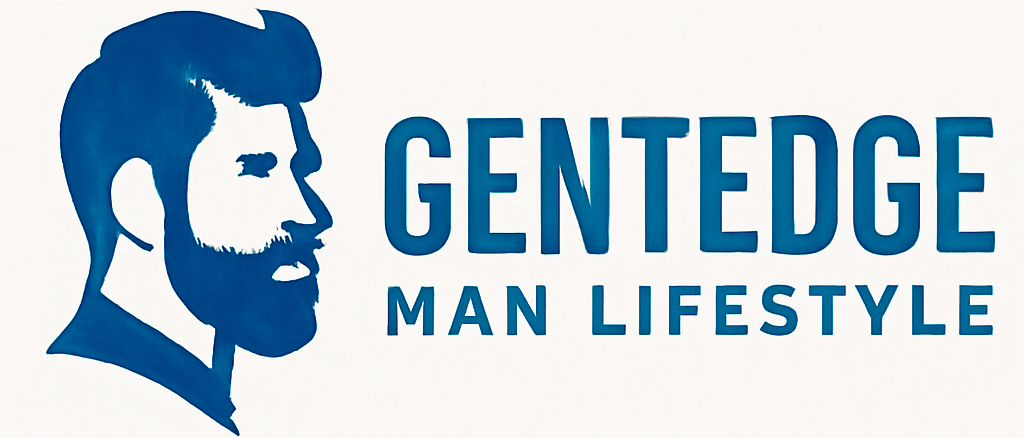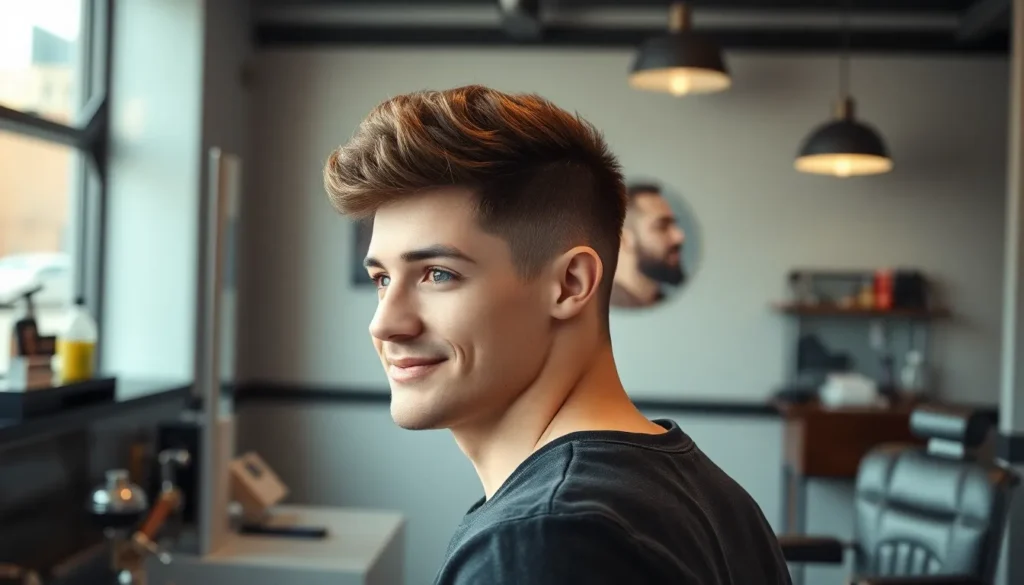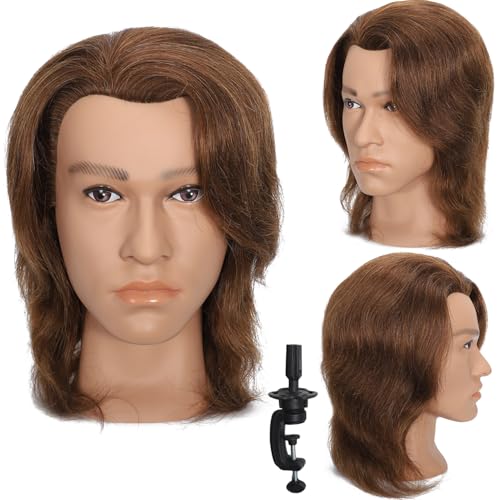Finding the perfect haircut when you’ve got a larger head can feel like handling a maze blindfolded. We’ve all been there – walking into a barbershop with high hopes only to leave feeling like our head looks even bigger than before. The truth is most stylists don’t understand the unique challenges that come with proportioning cuts for different head sizes.
But here’s what we’ve discovered after years of research and countless consultations with top barbers: the right haircut doesn’t just exist for men with big heads – it can actually become your greatest asset. We’re talking about cuts that create optical illusions, balance your features, and boost your confidence instantly.
The secret lies in understanding which styles work with your natural proportions rather than against them. We’ll show you exactly how to choose cuts that flatter your face shape while making your head appear perfectly proportioned.
Understanding Face Shape and Head Proportions for Men
We need to establish the fundamentals of head measurement and proportion analysis before selecting the perfect haircut. Understanding these key factors helps us make informed decisions that create visual balance and enhance our natural features.
Identifying Your Head Size and Shape
Measuring your head accurately starts with a flexible measuring tape positioned around the widest part of your skull. We recommend taking measurements at three key points: around the forehead and back of the head, from the top of the head to under the chin, and across the widest part of the temples. Most men with larger heads measure 23 inches or more in circumference compared to the average 22.5 inches.
Head shapes typically fall into five main categories that influence haircut selection. We classify these as oval, round, square, heart shaped, and oblong faces. Men with bigger heads often have round or square face shapes that require exact styling techniques to create proportion.
Visual assessment complements physical measurements when determining your head shape. We suggest standing in front of a mirror and tracing your face outline on the glass with a washable marker. This technique reveals whether your face is wider at the temples, cheekbones, or jawline.
Proportional analysis involves comparing your head width to your body frame and shoulder breadth. We find that men with broader shoulders can accommodate fuller hairstyles while those with narrower frames benefit from more tapered cuts. The golden ratio suggests that your face length should be approximately 1.6 times your face width for ideal proportions.
How Head Size Affects Haircut Choices
Larger heads require strategic volume management to avoid overwhelming your facial features. We recommend avoiding extremely short buzz cuts or skin fades that make the head appear disproportionately large. Instead, maintaining some length on top creates visual balance while shorter sides provide contrast.
Volume placement becomes crucial for men with bigger heads seeking proportional harmony. We suggest concentrating fullness at the crown and temples rather than the sides to elongate the face shape. Textured cuts with layers work particularly well because they break up the bulk without adding unwanted width.
Hairline considerations play a important role in selecting flattering styles for larger heads. We find that men with receding hairlines benefit from forward swept styles or subtle fringes that draw attention upward. Those with fuller hairlines can experiment with pushed back looks or side swept variations.
Professional consultation ensures optimal results when working with unique head proportions. We strongly advise discussing your head size concerns with an experienced barber who understands how different cutting techniques affect visual perception. They can recommend exact styles that complement your individual measurements and lifestyle needs.
Short Haircuts That Minimize Head Size
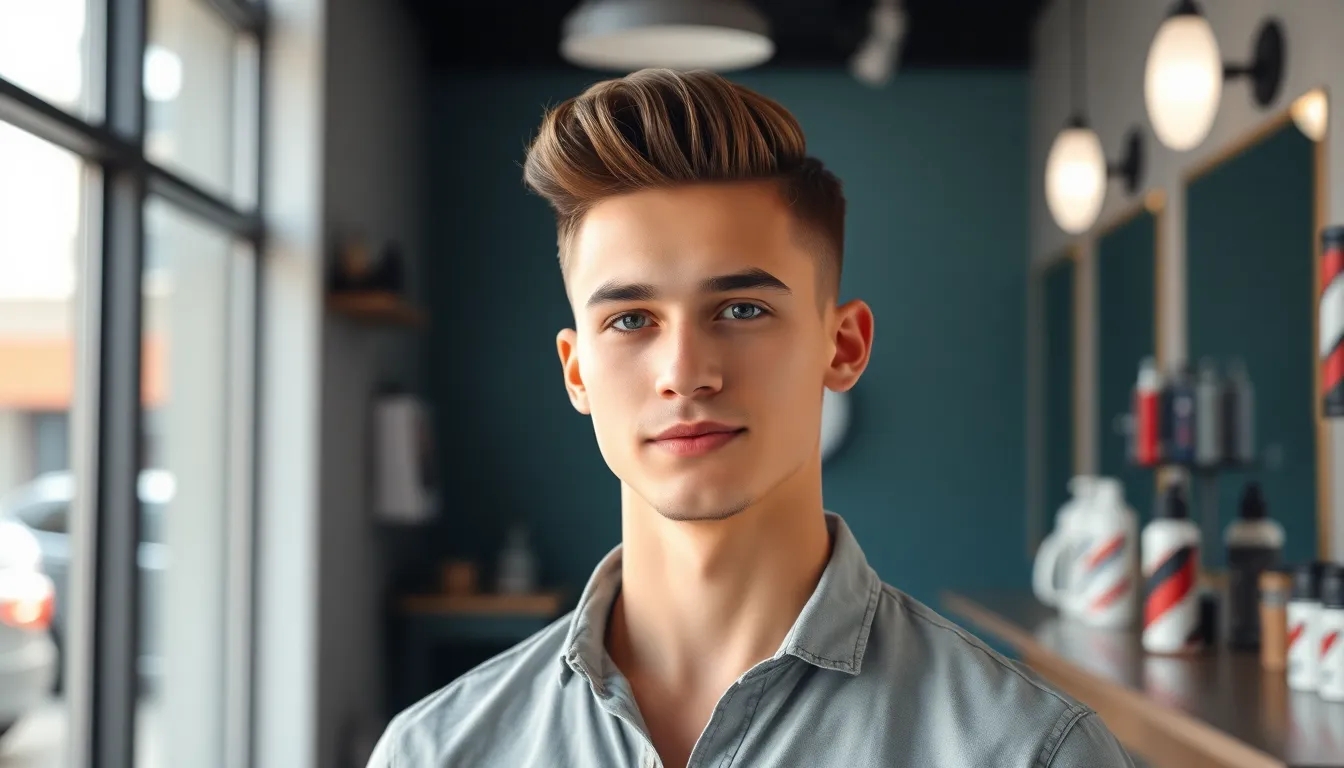
Strategic short hairstyles create visual balance by drawing attention away from head proportions while maintaining sharp, masculine appeal. These carefully selected cuts work with your natural features to achieve optimal proportional harmony.
The Classic Crew Cut
The classic crew cut delivers a streamlined appearance that’s particularly effective for larger head proportions. This style maintains the same length throughout the entire head, typically around half an inch to one inch, creating uniformity that minimizes visual bulk. Professional barbers consistently recommend this cut because it eliminates weight around the sides and back while keeping enough length on top to prevent an overly severe look.
Modern variations of the crew cut include subtle fades at the temples and neckline. These gradual transitions help soften the overall silhouette without compromising the style’s clean aesthetic. The key advantage lies in its ability to create a proportional framework that doesn’t compete with your facial features.
Textured Crop Cuts
Textured crop cuts add strategic visual interest through carefully placed layers and movement throughout the hair. This technique breaks up solid masses of hair that might otherwise emphasize head size, instead creating depth and dimension. Expert stylists achieve this look by incorporating point cutting and razor techniques that produce natural texture variations.
The textured approach works exceptionally well when combined with subtle fades or undercuts along the perimeter. These elements draw the eye toward the textural details rather than the overall head shape. Popular texture patterns include choppy layers on top with gradually shorter sides, creating a balanced contrast that flatters larger proportions.
Side-Parted Short Styles
Side parted short styles introduce asymmetrical elements that break up the natural roundness or width of larger heads. The strategic placement of the part creates visual lines that guide the eye horizontally rather than emphasizing vertical proportions. This technique proves especially effective when the part falls approximately two inches from the center line.
These styles typically feature slightly longer hair on one side of the part, ranging from one to two inches in length. The shorter side maintains a clean, tapered appearance that doesn’t add bulk to the head’s silhouette. Professional execution ensures the part line remains crisp and well defined, creating the structured look that’s essential for this style’s effectiveness.
Medium-Length Styles for Balanced Proportions

Medium length cuts offer versatility and visual balance that work exceptionally well for men with larger heads. These styles create proportional harmony while maintaining enough length to add dimension and movement.
Layered Side Swept Hair
Side swept bangs create asymmetrical lines that effectively mask forehead width while adding sophisticated elegance to your overall appearance. We recommend this versatile approach because it naturally draws attention away from head proportions and toward facial features. Professional stylists can tailor this cut for both casual everyday wear and formal occasions, making it one of our most recommended options.
The layered approach adds depth and movement that prevents hair from lying flat against your head. Stylists achieve this balance by cutting varying lengths throughout the top section while maintaining clean sides. This technique creates visual interest that distracts from head size while improving your natural bone structure.
Modern Quiff Variations
Modern pompadours focus attention directly on the crown area, which helps evening out facial proportions and creates an undeniably charismatic appearance. We’ve found this style particularly effective because it draws the eye upward rather than emphasizing width. The elevated front section creates vertical lines that naturally elongate your face shape.
Brush up hairstyles take this concept further by styling hair upward to add important volume and create more ever-changing movement. This technique works especially well for men with thicker hair textures who want to maximize their natural volume. The upward motion creates height that balances larger head proportions while maintaining a modern, trendy appearance.
Messy Textured Styles
Textured crops add deliberate texture throughout the hair, which effectively diverts attention from forehead prominence while creating a perfectly balanced overall look. We particularly favor this approach because the varied lengths and choppy layers break up solid shapes that might emphasize head size. The intentionally tousled appearance adds casual sophistication that works across different age groups.
Messy texture incorporates strategic layers and movement that naturally draw attention away from the forehead while improving your best facial features with a contemporary, trendy appearance. This styling approach uses different cutting techniques to create organic looking texture that appears effortless yet polished. The varied lengths throughout create visual interest that makes heads appear more proportionate while maintaining an approachable, masculine aesthetic.
Long Haircuts That Create Visual Balance
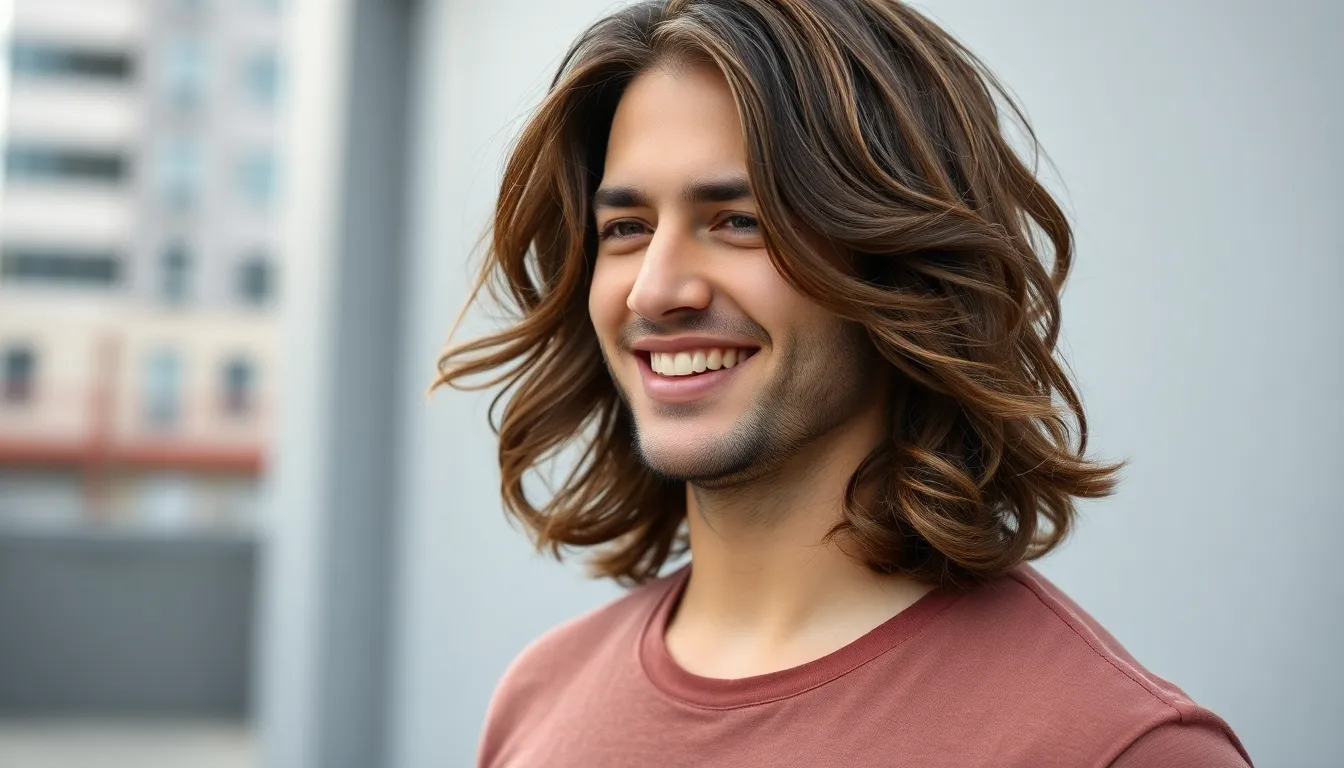
Longer hairstyles offer exceptional flexibility for men with bigger heads, allowing us to redistribute visual weight and create proportional harmony. These styles excel at drawing attention away from head size while improving natural facial features.
Shoulder-Length Layered Cuts
Shoulder-length layered cuts distribute volume evenly around the face and head, creating a more balanced appearance that complements larger proportions. Layers add essential texture and movement that enhance facial features while softening the overall silhouette. We recommend incorporating graduated layers that start around the jawline, as they create natural flow and prevent the hair from appearing too heavy or overwhelming.
Strategic layering techniques help break up visual bulk while maintaining sophisticated styling options. Professional stylists can customize layer placement to suit your exact face shape, whether you have round, square, or oblong features. Volume distribution becomes more controlled with proper layering, allowing the hair to frame your face naturally rather than adding width where it’s not needed.
Man Buns and Top Knots
Man buns and top knots elongate the face while drawing attention to the hair rather than head size, making them excellent choices for creating vertical lines. These versatile styles adapt to both casual and formal occasions, offering practical answers for longer hair management. We’ve found that positioning the bun higher on the crown creates the most flattering proportions for men with larger heads.
Top knots work particularly well because they add height above the forehead, creating visual balance through upward movement. Textured buns with slightly messy finishes appear more natural and less severe than perfectly smooth styles. Undercut variations can be incorporated to reduce bulk on the sides while maintaining the elongating effect of the top knot.
Long Textured Waves
Long textured waves add depth and dimension while softening the appearance of a large head through natural movement and visual interest. Textured waves distract from head shape by focusing attention on the hair’s ever-changing flow and styling versatility. We recommend improving natural wave patterns rather than creating artificial texture, as this produces more authentic and flattering results.
Wave definition becomes crucial for achieving the right balance between structure and softness. Salt spray products and diffusing techniques help enhance natural texture without weighing down the hair or creating unwanted bulk. Layered cutting approaches work exceptionally well with wavy hair, as they prevent the triangular shape that can occur with uniform length cuts.
Styling Techniques to Reduce Head Appearance
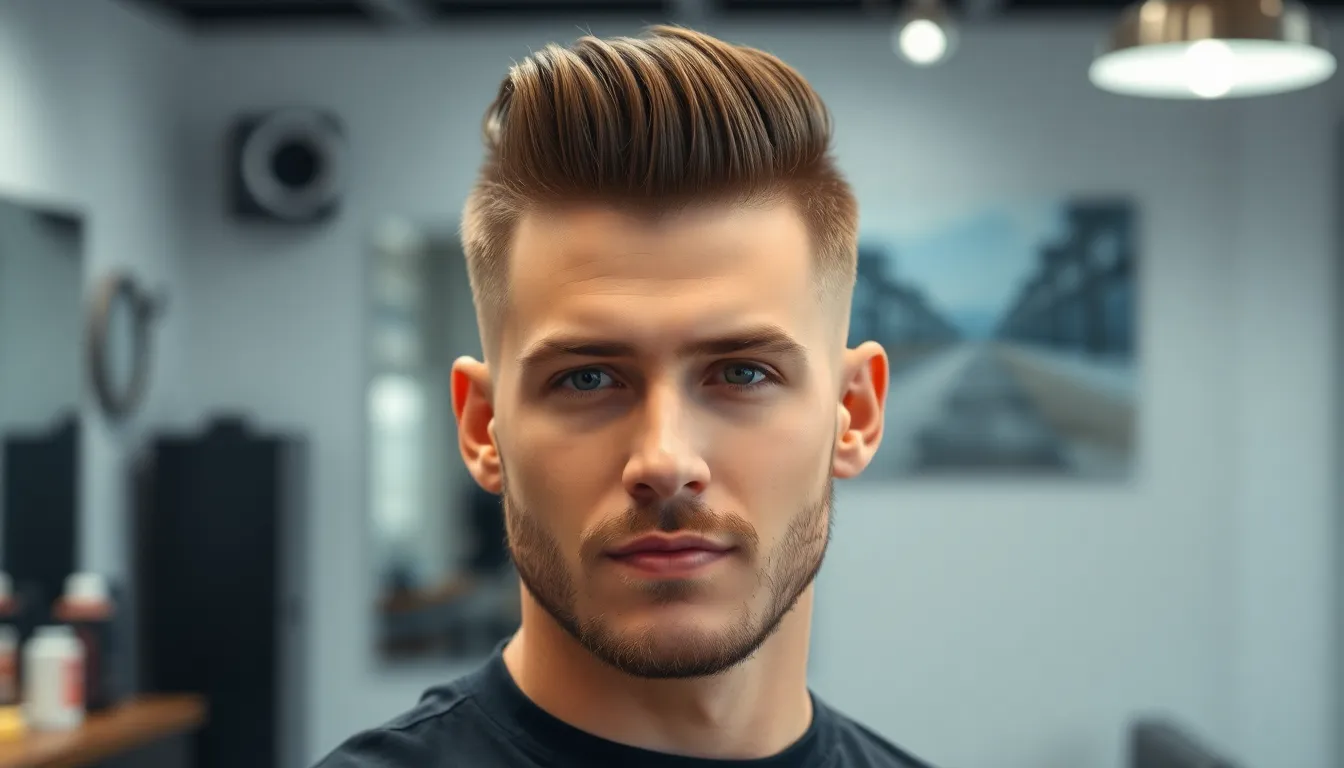
Beyond choosing the right cut length, exact styling approaches can dramatically minimize the appearance of a larger head. These proven techniques work by manipulating visual proportions and redirecting attention to create a more balanced overall look.
Adding Volume on the Sides
Fade cuts represent one of our most effective strategies for creating visual balance. A fade cut accentuates the hair on top while gradually reducing length on the sides, creating a stylish display of volume that shifts attention away from the head’s width. This technique works by concentrating visual weight at the crown rather than the temples.
Short layers on the sides help break up the rounded appearance that often accompanies larger heads. When we combine these layers with longer hair on top, the contrast creates an illusion of reduced head size. The key lies in maintaining enough texture to avoid a flat, uniform look that can emphasize roundness.
Strategic side styling involves building subtle volume at the ear level and above. This approach counteracts the natural tendency for larger heads to appear bottom heavy. Professional stylists often use texturizing techniques to create this controlled volume without making the sides appear bulky.
Creating Horizontal Lines
Caesar cuts feature horizontally straight bangs that create an effective illusion of reduced forehead height. The horizontal line breaks up vertical space and helps balance facial proportions, making this cut particularly effective for men with prominent foreheads or elongated face shapes.
Textured crops add layers and movement through strategic horizontal cutting techniques. These cuts create a more ever-changing silhouette that distracts from overall head size by introducing multiple visual focal points. The texture prevents the eye from reading the head as one large, uniform shape.
Fringe variations work by creating strong horizontal elements across the forehead. Whether straight across or slightly angled, these cuts establish a clear visual break that reduces the perceived height of the face and forehead area.
Using Hair Products Strategically
Styling products like pomades and texturizers enhance volume on top while keeping sides clean and controlled. This strategic application creates the ideal contrast needed to minimize head size appearance. Medium hold products work best as they provide structure without weighing down the hair.
Volume improving techniques focus on lifting hair at the crown and front sections. We recommend applying volumizing mousse to damp hair before blow drying, concentrating the product where you want maximum lift. This creates vertical height that elongates the face shape.
Texture creation through salt sprays and texturizing powders adds visual interest and breaks up solid masses of hair. These products help create the layered, multidimensional look that prevents the head from appearing as one large, uniform shape. Apply these products sparingly to avoid overwhelming fine hair textures.
Haircuts to Avoid for Men with Big Heads
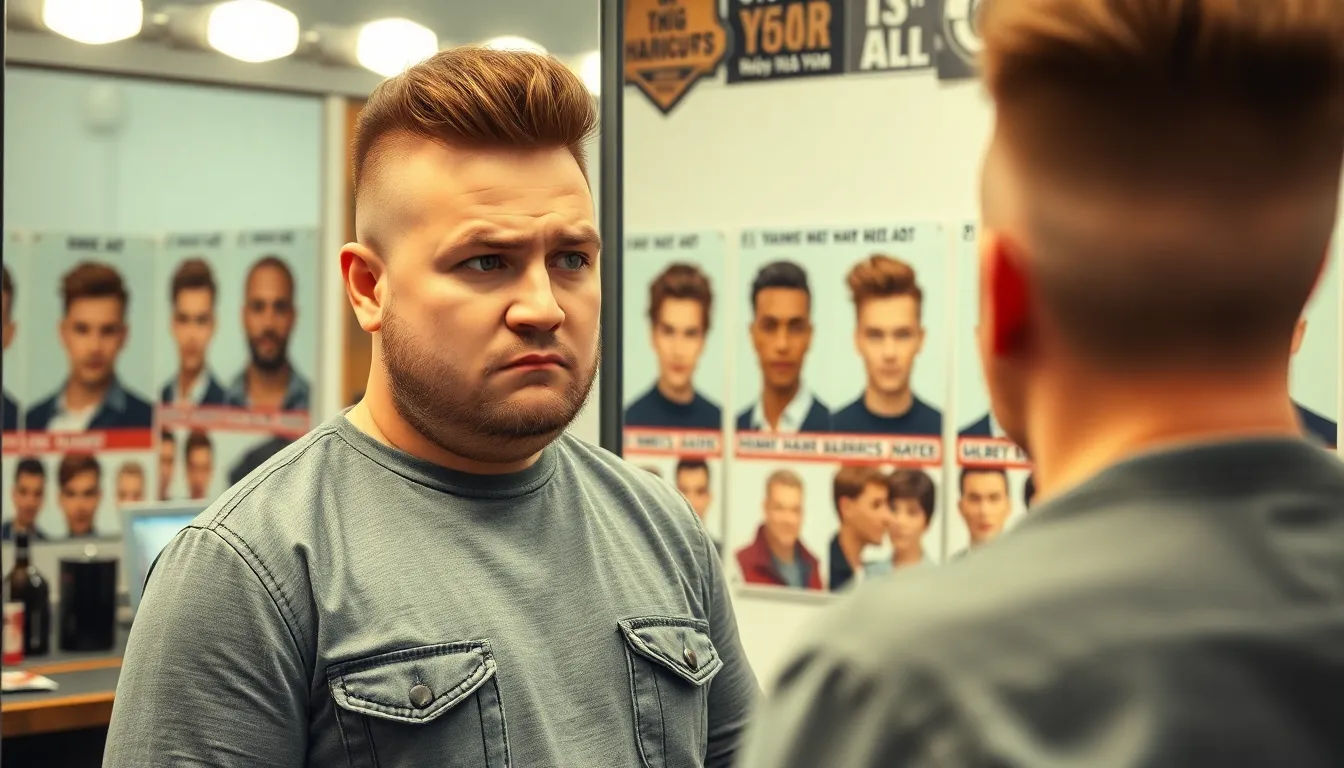
While we’ve explored many flattering options, certain hairstyles can actually emphasize head size rather than minimizing it. These styles typically remove volume or create lines that draw unwanted attention to proportions.
Buzz Cuts and Very Short Styles
Buzz cuts eliminate the visual balance that longer hair provides on top of your head. These extremely short styles create a uniform appearance that makes the skull’s natural shape more prominent and noticeable.
Military style buzz cuts remove all opportunities for strategic volume placement around the crown area. Without hair to soften facial features, your head’s actual dimensions become the focal point of your overall appearance.
Close cropped styles also eliminate texture and dimension that help break up the visual weight of larger heads. We recommend avoiding anything shorter than a #3 guard, as these lengths fail to provide adequate coverage for proportional balance.
Slicked-Back Looks
Slicked back hairstyles pull all hair away from the forehead, creating an unobstructed view of your head’s full width. This styling technique emphasizes forehead prominence while removing any softening elements around the face.
Pompadour variations that sweep hair completely backward can make the forehead appear even more expansive than it naturally is. These styles create clean lines that highlight rather than disguise larger proportions.
Wet look styling products compound this problem by creating a flat, uniform surface that reflects light directly off the scalp. We’ve observed that these slicked styles tend to make heads appear larger and more pronounced in professional and social settings.
High and Tight Military Cuts
High and tight cuts combine the worst elements of both buzz cuts and slicked styles for men with bigger heads. These military inspired haircuts feature extremely short sides with minimal length on top, creating stark contrasts that emphasize head shape.
Fade variations of high and tight styles draw attention upward toward the crown while providing no volume to balance facial proportions. The dramatic length difference between top and sides creates visual lines that accentuate rather than minimize head size.
Traditional military cuts prioritize uniformity and practicality over aesthetic balance, making them unsuitable for civilian styling goals. We recommend avoiding any style that combines ultra short sides with minimal top length, as these proportions typically overwhelm facial features rather than improving them.
Professional Consultation and Maintenance Tips
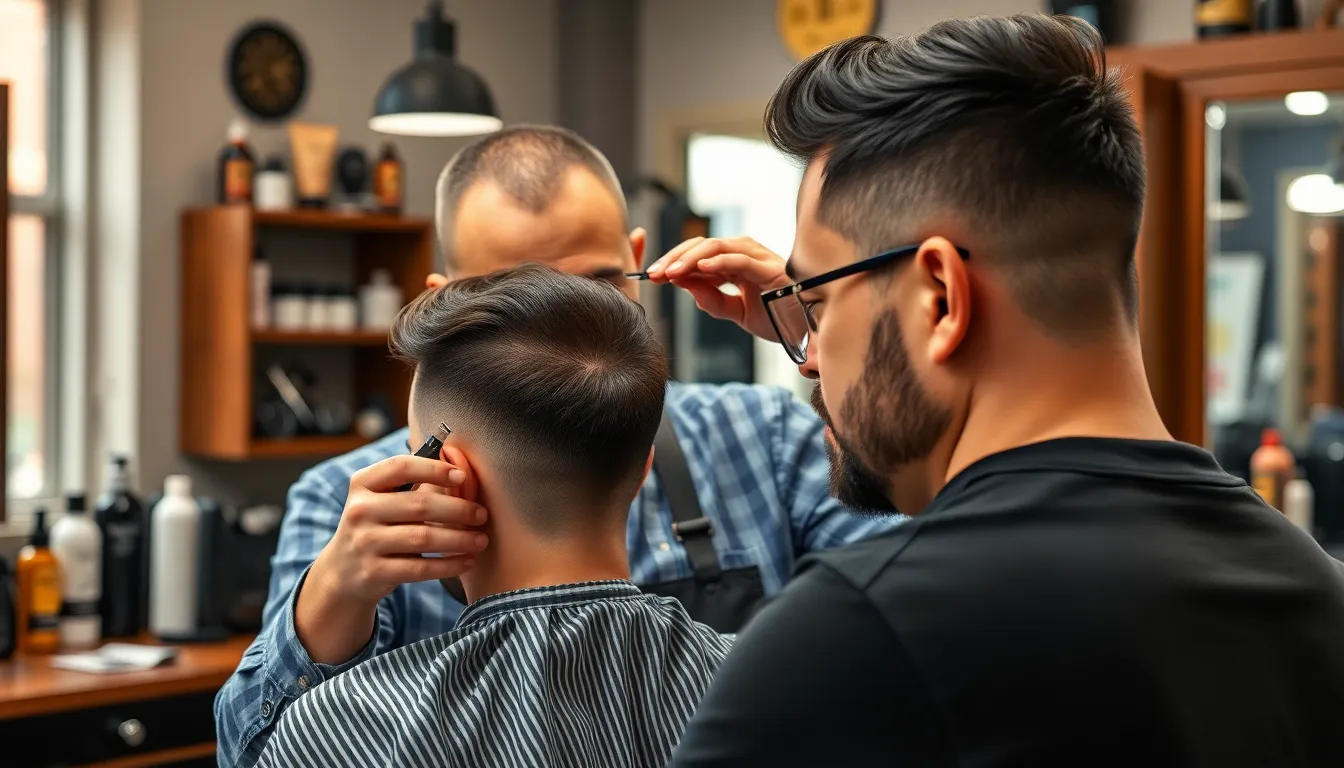
Getting the right haircut for a larger head requires expert guidance and consistent upkeep. We’ve found that professional consultation combined with proper maintenance routines makes all the difference in achieving a balanced, flattering look.
Finding the Right Barber or Stylist
Researching experienced professionals who understand head proportions is your first step toward success. Look for barbers with positive reviews specifically mentioning work with various head shapes and sizes. Many skilled professionals like Greg Young have built reputations for their expertise in styling larger heads through specialized consultations.
Asking for referrals from friends with similar head shapes often leads to discovering talented stylists in your area. Check online portfolios and before-and-after photos to see actual results with clients who have proportional challenges. Some barbers even offer downloadable resources or tutorials specifically designed for big head styling techniques.
Scheduling a consultation before your first cut allows the barber to assess your unique head shape and facial structure. During this meeting, discuss your lifestyle, styling preferences, and any previous haircut disappointments. Professional stylists can recommend exact cuts that complement your features while explaining why certain styles work better than others.
Regular Trimming Schedules
Maintaining your haircut every 4-6 weeks keeps the proportions balanced and prevents unwanted bulk from developing. Short and tapered styles require more frequent touch-ups since even small amounts of growth can disrupt the carefully crafted balance. We recommend booking your next appointment before leaving the barbershop to ensure consistency.
Scheduling varies by style complexity and hair growth rate, with textured crops needing attention every 4 weeks while longer layered cuts can go 6-8 weeks between visits. Fast-growing hair may require side and back trims between full cuts to maintain the tapered effect. Track your hair’s growth pattern to establish a personalized maintenance schedule.
Missing appointments often results in styles that emphasize rather than minimize head size, as overgrown hair loses its structured shape. Set calendar reminders and consider standing appointments with your preferred barber to maintain optimal results consistently.
At-Home Styling Techniques
Using clippers with appropriate guard lengths helps maintain short sides and back between professional visits. Start with longer guards like #3 or #4 and work down gradually to avoid cutting too much hair. Focus on keeping the tapered areas neat while leaving the top section for professional handling.
Applying lightweight products like pomade or clay adds definition without creating unwanted bulk that can make your head appear larger. Use a small amount and work it through damp hair for best results. Avoid heavy creams or gels that add excessive volume or weight to your style.
Styling techniques matter as much as product choice when maintaining your cut at home. Brush hair forward and up at the crown to create vertical lines that elongate your face shape. Keep sides smooth and close to the head while adding subtle texture on top for visual interest without bulk.
Avoiding over-styling prevents your hair from looking unnatural or adding unnecessary volume in the wrong places. Less is more when it comes to daily maintenance, so stick to simple techniques that enhance your professional cut rather than competing with it.
Conclusion
Finding the perfect haircut when you have a larger head doesn’t have to be an ongoing struggle. We’ve shown you that with the right techniques and professional guidance you can achieve a balanced and confident look that enhances your best features.
The key lies in understanding your unique proportions and choosing styles that create visual harmony. Whether you prefer short textured crops medium-length quiffs or longer layered cuts there’s a perfect option waiting for you.
Remember that regular maintenance and the right products make all the difference in keeping your style looking sharp. With these expert insights you’re now equipped to walk into any barbershop with confidence and leave looking your absolute best.
Frequently Asked Questions
What head circumference is considered large for men?
Most men with larger heads measure 23 inches or more in circumference. To measure accurately, wrap a tape measure around the widest part of your head, just above your eyebrows and ears. This measurement helps determine which haircut styles will work best for your proportions and facial features.
Which head shapes require special styling considerations?
Round and square head shapes typically require the most strategic styling approaches. These shapes benefit from techniques that add height on top while keeping sides shorter. Heart-shaped, oval, and oblong faces also need specific considerations, but round and square faces present the biggest challenges for creating visual balance.
Should men with large heads avoid very short haircuts?
Yes, extremely short styles like buzz cuts can make large heads appear even more prominent by emphasizing the skull’s natural shape. Instead, maintain some length on top for visual balance. Short styles can work, but they should include strategic layering, texturing, or subtle fades to soften the overall silhouette.
What are the best short hairstyles for larger heads?
Classic crew cuts with subtle fades, textured crop cuts, and side-parted short styles work excellently. These cuts create visual balance through strategic length distribution. Textured crops add depth through layers, while side-parted styles introduce asymmetry that breaks up roundness and draws attention away from head proportions.
How do medium-length styles benefit men with large heads?
Medium-length styles offer versatility and natural visual balance. Layered side-swept cuts create asymmetrical lines that mask forehead width, while modern quiff variations draw attention upward with vertical lines. Messy textured styles incorporate movement and layers that divert attention from forehead prominence while maintaining contemporary appeal.
Can men with large heads wear long hairstyles?
Absolutely. Long hairstyles can create excellent visual balance when styled properly. Shoulder-length layered cuts distribute volume evenly, while man buns and top knots create elongating effects. Long textured waves provide natural movement that distracts from head shape while enhancing facial features and creating proportional harmony.
What styling techniques help minimize head size appearance?
Fade cuts are highly effective, accentuating volume on top while tapering sides for balance. Short layers on the sides break up roundness, while strategic side styling adds volume at ear level. Horizontal lines from Caesar cuts and textured crops visually reduce forehead height and balance facial proportions.
How often should men with large heads get haircuts?
Regular trimming every 4-6 weeks is essential to maintain balance and prevent bulk buildup. Consistent maintenance keeps the haircut’s shape and proportions intact. Between visits, focus on proper styling techniques and product use to enhance the cut without adding unnecessary volume that could emphasize head size.
What hair products work best for larger heads?
Pomades and volumizing mousse are excellent choices for creating strategic volume on top while keeping sides controlled. These products help achieve a multidimensional look that prevents the head from appearing as a uniform shape. Avoid heavy products that add bulk or weight to the sides.
Which haircuts should men with large heads avoid?
Avoid buzz cuts, slicked-back styles, and any uniform-length cuts that emphasize the skull’s natural shape. Also steer clear of styles that add width to the sides or create horizontal emphasis. These cuts can make large heads appear even more prominent and fail to create the visual balance needed for flattering proportions.
